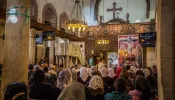Beauty’s power is often disregarded. When we think of power, our minds often turn to weapons of mass destruction, or tornados, tsunamis and other natural disasters; we may think of money and political power. But what is good, true and beautiful has a kind of power that evades and surpasses all others. Its power comes from its ability to answer the deepest needs of the human heart, and therefore its ability to inspire.
Our need for Beauty
During a visit last November to Spain for the consecration of the magnificent Church of the Sagrada Familia, Pope Benedict XVI spoke of our need for beauty. He said, “Indeed, beauty is one of mankind’s greatest needs; it is the root from which the branches of our peace and the fruits of our hope come forth.”
Beauty leads us into an encounter with God, who is Truth and Beauty itself. You might say that we are “wired” by God for beauty and our desire for Him is planted deep in human nature. Our encounter with the Lord happens in the Church through her sacred architecture, art and music, and most especially through her Sacred Liturgy. It is especially in the eucharistic liturgy that the love of God in Christ Jesus, which surpasses all other beauty, is made present to us. This love has the power to transform every human heart as it affirms the dignity of each person made in the divine image.
Our Holy Father said (The Spirit of the Liturgy, p. 126) “The beautiful and the good, ultimately the beautiful and God, coincide. Through the appearance of the beautiful we are wounded in our innermost being, and that wound grips us and takes us beyond ourselves; it stirs longing into flight and moves us toward the truly Beautiful, to the Good in itself.” The experience of beauty corresponds to our longing for God. Thus, beauty lifts us above our daily routine and worldly cares; it draws us into communion with Christ in His Paschal Mystery; it assists us to keep our eyes fixed on the things that will never end. This is why the Church takes such great care to cultivate beauty in the Sacred Liturgy, including in the texts we pray at Mass.
Beauty’s power to evangelize
The new English translation of the Roman Missal uses language that is easily understandable yet not mundane. It preserves the doctrinal precision found in the original Latin text while displaying its inherent dignity and beauty.
The beautiful Latin text itself does not come out of a vacuum. It stands in organic continuity with 20 centuries of rich liturgical tradition. Great care has been taken so that the beauty of this tradition is not lost in translation. This is why the guidelines for translating the original Latin text say (Liturgiam Authenticam, #20), “…the translation is not so much a work of creative innovation as it is of rendering the original texts faithfully and accurately into the vernacular language.”
When the elevated dignity of the Latin text is preserved, the Church’s mission of evangelization is greatly enhanced because authentic inculturation occurs. As Liturgiam Authenticam states (#5), “Indeed, it may be affirmed that the Roman Rite is itself already a precious example and an instrument of true inculturation. For the Roman Rite is marked by a signal capacity for assimilating into itself spoken and sung texts, gestures and rites derived from the customs and the genius of diverse nations and particular Churches — both Eastern and Western — into a harmonious unity that transcends the boundaries of any single region.” The deepest beauty of the Latin texts of the Roman Rite is not merely linguistic or literary but theological, expressing the Church’s universal and missionary nature in all times and places.
Beauty’s transforming effect
At the general audience of May 21, 2008, Pope Benedict XVI said: “Faith is love, and so it creates poetry and music. Faith is joy, and so it creates beauty.” Nowhere is this more fully displayed than in the Sacred Liturgy. While a reverential gravitas marks the Eucharistic Sacrifice, there is also a joy that the world cannot give. This joy lifts our thoughts heavenward and inspires works of charity, truth and justice on earth.
Cardinal Ratzinger (now Benedict XVI) writes (On the Way to Jesus Christ, p. 36-38): “The encounter with beauty can become the wound of the arrow that strikes the soul and thus makes it see clearly, so that henceforth it has criteria, based on what it has experienced, and can now weigh the arguments correctly… In this way it [beauty] brings us into contact with the power of truth. I have often said that I am convinced that the true apologetics for the Christian message, the most persuasive proof of its truth, offsetting everything that may appear negative, are the saints, on the one hand, and the beauty that the faith has generated, on the other. For faith to grow today, we must lead ourselves and the persons we meet to encounter the saints and to come in contact with the beautiful.”
The care we take to understand the beauty of the liturgy, the efforts we are making now to appreciate and to pray with the new English translation of the Roman Missal will bear rich fruit in our personal lives as it also gives glory to God. Since beauty enthuses us to be something and to do something more than we’ve been and done before, it inspires us to be more joyful and compelling witnesses to Christ in our day. Since the Sacred Liturgy reaches beyond earthly life into eternal life, and since it gives us a share in heavenly existence, it causes the brilliance of the Blessed Trinity to shine within our world.
Printed with permission from the Catholic Sun, newspaper for the Diocese of Phoenix.











